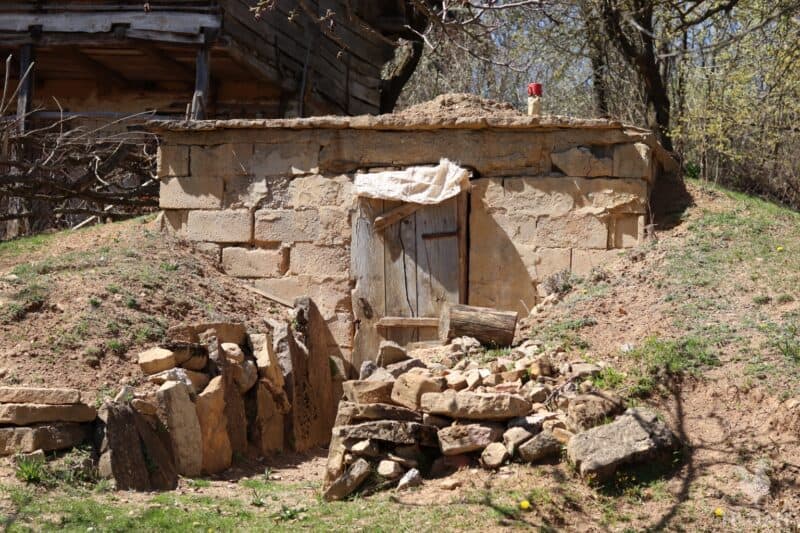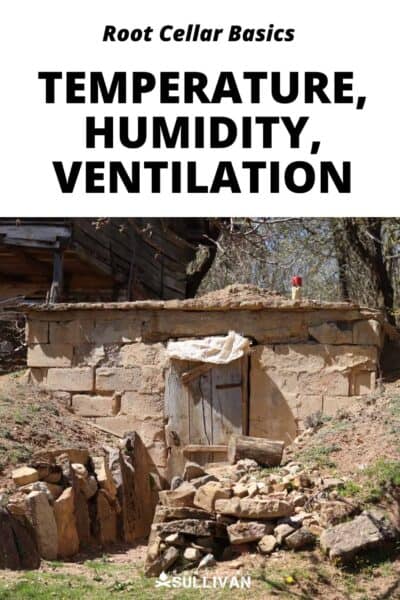One thing that I think we all take for granted these days is the ubiquity of food preservation technology.
Whatever you bring in, whatever is left over, toss it in the fridge or in the freezer, and forget about it until it’s time to eat. But food preservation was a very different thing prior to the advent of these miraculous things!

Nonetheless, it was still possible, and one ancient bit of technology that is making a big comeback today with homesteaders and all folks who want to be a little more self-sufficient is the root cellar.
They are as functional now as they were way back when, but just what is the ideal temperature of a root cellar?
The ideal temperature of a root cellar is between 32° F and 40° F (between 0°C and 4.5° C. This is about the temperature of a modern refrigerator, but depending on the design of your root cellar and the climate where you are, it can be difficult to maintain this target temp.
If you want to preserve your food for the long haul in your root cellar, it needs to be downright chilly. That being said, it doesn’t mean that your efforts are fruitless or that you can’t keep something longer than you would normally if your root cellar is a little warmer than that.
Trust me, there is a whole lot more that you’ll need to know whether you’ve already got your own root cellar or are thinking of installing one. Keep reading and I’ll tell you everything.
How Can You Keep a Root Cellar Cold Enough?
Probably the biggest challenge, and the single most common question I get about root cellars, is how to keep them cold enough. Like I said above, if your root cellar is optimized it will be quite chilly, as chilly as the refrigerator in your kitchen.
How are you supposed to keep what is basically an underground or partially underground room that cold? Well, it isn’t easy assuming you haven’t installed refrigeration technology which basically turns it into a walk-in chiller!
The great thing about a root cellar is that it will naturally be quite a bit colder than the air outside or above ground simply by the benefit of being subterranean.
Soil is a tremendous insulator, and the ground itself is basically one gargantuan heatsink. Properly constructed and properly insulated, your root cellar will be anywhere from 10° to 20° colder than the ambient air temperature, and potentially colder yet.
But ultimately that isn’t cold enough, not in most places. Root cellars tend to be at their best if you live somewhere in a northern or southern latitude when it is naturally much colder year-round.
Good location, combined with proper siting and construction, will make a root cellar extremely effective.
What Happens if Your Cellar is a Little Warmer?
If it’s warmer than the prescribed temperature range your food will obviously not stay fresh for as long, and some can’t be reliably stored at all. Fruits, especially, don’t do well if the cellar is a little bit warmer than a truly cold 32° to 40° F.
Now, chances are you don’t live in a region or experience a climate that’s truly ideal for root cellar usage. Even with ideal construction techniques, your root cellar is probably going to be a fair bit warmer, anywhere from 41° to 55° F, and hopefully no warmer than that.
In that case, there are still many foods that will benefit from root cellar storage, and that somewhat higher range is actually ideal for certain vegetables like potatoes, sweet potatoes, and onions. It’s all in the name, root cellar!
Can You Still Store Food in a Cellar Warmer than 32°F?
Yes, you can, but you need to know that the ideal temperature range of various fruits and veggies varies considerably, and some items won’t do well at all unless kept truly cool.
For instance, apples and pears need to be very cold, preferably no higher than 31° F if you want them to keep for a few months. Broccoli, likewise needs to be quite cold at 30° to 32° F and even then, that will only get you a couple of weeks.
Most other types of fruit, particularly citrus fruits, need to be kept very cool for maximum longevity, and even then you’re looking at about 2 months on the outside.
If your root cellar is above these temperatures, it’s still worth keeping these foods in there compared to just sitting on your counter or in a nice warm, stuffy pantry, but understand that you’re not going to get as long a storage life as you would normally.
On the other hand, quite a few veggies do wonderfully in slightly warmer cellars, like the aforementioned potatoes, sweet potatoes, and onions.
Sweet potatoes are actually best if kept anywhere between 55° and 60° F which is relatively balmy for a root cellar, whereas potatoes do well a little bit cooler between 40° and 45° F.
Onions are quite adaptable and can be kept for a very long time as long as they are cool and dry.
Don’t Forget that Humidity is Also a Factor
Don’t forget, temperature isn’t everything when it comes to keeping food in a root cellar! Ideally, your root cellar should have a constant humidity level of between 85% and 95%. That will keep your produce from shriveling up and turning into desiccated little husks.
Learn the Temperature Map of Your Root Cellar
One worthwhile exercise to get the most from your root cellar is to understand the “temperature map”. That’s not a scientific term, that’s my term for learning where your root cellar is a little bit warmer, a little bit cooler, and which spots experience an influx of more humidity or less.
This knowledge will help you effectively place different kinds of produce for maximum shelf life and stability.
For instance, most folks know that cold air sinks, and accordingly the lower shelves and the floor will have a somewhat cooler temperature compared to the uppermost shells near the ceiling- warmer air rises.
Likewise, if you live in a really cold area, cool air will seep in around windows and doors, chilling these zones a little more than the average.
Humidity is more or less a constant unless you do something to significantly impact it, but even the movement of air currents will cause certain spots to be noticeably drier.
Keep all of this in mind and use a good thermometer or two to figure this out before you stock your root cellar.
Controlling and Stabilizing Your Root Cellar’s Temp?
Assuming you aren’t equipping your cellar with any sort of refrigeration technology or improving the insulation factor somehow, your only options for changing the temperature are to let air in, keep air out, keep light out, or let light in.
Also, consider installing an airlock or double door to help prevent a major influx of significantly warmer or cooler air from outside the cellar whenever you enter and exit.
And definitely don’t underestimate the effects of light! Sunlight streaming in through any windows can significantly warm the space, and even a single incandescent light bulb can make a big difference, so you never want to leave that on when you aren’t inside.
And if you’re planning on installing, remember that the deeper you go the cooler it will be, all things being equal. So do what you can!
Don’t Forget About Ventilation
Ventilation isn’t just to prevent the growth of mold. It also helps keep the temperature lower, although how you make it as well as your climate have a say in exactly how low a temperature would something like a vent be able to keep.
There are various methods folks have used over the centuries to ventilate their root cellar, but a couple of vents, one at the top and one at the bottom are the most common choice. Place these on opposite walls for better airflow circulation.
Make sure you can control if and how much you close these for even more accurate temperature control.

Tom has lived and worked on farms and homesteads from the Carolinas to Kentucky and beyond. He is passionate about helping people prepare for tough times by embracing lifestyles of self-sufficiency.
